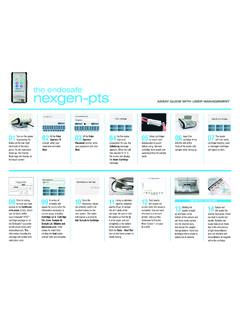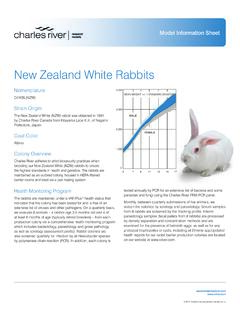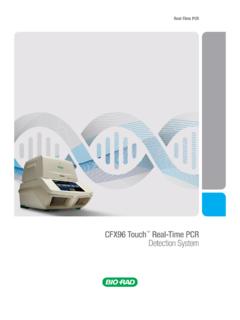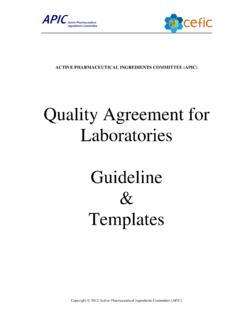Transcription of C57BL/6 Mice Datasheet - Charles River Laboratories
1 STEP OF THE WAYRESEARCH MODELSC57BL/6 MiceNomenclature: C57BL/6 NCrlStrain OriginDeveloped by Little in 1921 from a mating of Miss Abbie Lathrop s stock that also gave rise to strains C57BR and C57L. Strains 6 and 10 separated about 1937. To The Jackson Laboratory from Hall in 1948. To NIH in 1951 from The Jackson Laboratory at F32. To Charles River in 1974 from NIH. Coat ColorBlackAvailabilityNorth America, Europe, China, and JapanResearch Applications Metabolic Disease Oncology Immunology Cardiology Addiction Toxicology Transgenic Model CreationGerm-Free (GF) Axenic Free of all microorganismsVAF/Elite (SOPF) Free of all agents listed in the VAF / Plus mouse profile, plus the opportunists Beta hemolytic Streptococcus spp.
2 , K. oxytoca, K. pneumoniae, P. pneumotropica, P. aeruginosa, P. mirabilis, S. aureusVAF/Plus (SPF) Free of rodent pathogensGerm-FreeVAF/Elite VAF/Plus Charles River Health Profiles for C57BL/6 NGenetic Management of C57BL/6 Mouse Colony Inbred strains are defined as animals produced by a minimum of 20 generations of brother-sister mating, traceable to a single founding pair. Individuals of an inbred strain are genetically uniform, also known as isogeneic. Inbred strains exhibit a high degree of uniformity in their inherited characteristics, or phenotypes, which include appearance, behavior, physiology, and responses to experimental treatments.
3 Charles River uses our International Genetic Standardization (IGS) program coupled with a pyramid mating system designed to maintain authenticity and the highest possible levels of genetic uniformity. The pyramid mating system (see Figure 1) ensures that our C57BL/6 colonies are genetically identical within each strain ( , fundamentally free of genetic differences that could increase variation in experimental results). In this system, the foundation colony serves as the genetic and health standard and provides breeders for the top level of the pyramid in every barrier room.
4 This top level, the nucleus colony, is composed of a relatively small number of pedigreed brother-sister mating pairs that produce breeders for the next level of the pyramid, in addition to replenishing itself. In larger colonies, the next level is called the expansion colony, and it provides breeders to the production colony, which in turn produces the animals that are commercially available. The unidirectional flow of breed stock in this system helps to ensure that any genetic changes or mutations, which would be most likely to occur in the more populous expansion or production colonies than in the smaller nucleus colony, will wash out within a single generation.
5 Nucleus colonies are replaced every three to five years (within 10 generations) by migrating new breed stock from the foundation colony to the barrier rooms. As a safeguard against any large scale disaster affecting the foundation colonies of several strains, Charles River has cryopreserved a sufficient number of embryos for multiple, complete replacements of those populations. For further information regarding Charles River s IGS program, please refer to the IGS Technical Sheet found at 1: Pyramid Mating SystemC57BL/6 River C57BL/6 NCrl DataClinical ChemistryC57BL/6 NCrl*ALB (g/dL)ALK(U/L)A LT(U/L)AST(U/L)TBIL(mg/dL)BUN(mg/dL)Ca(m g/dL)CL(meq/L)CHOL(mg/dL)Male Mean *CRE (mg/dL)GGT(U/L)GLU(mg/dL)P(mg/dL)K+(meq/ L)NA(meq/L)TPR(g/dL)TRIG(mg/dL)Male Mean *WBC (K/ L)RBC(M/ L)HGB(g/dL)HCT(%)MCV(fL)MCH(pg)MCHC(g/dL )RDW(%)Male Mean *P LT (K/ L)MPV(fL)NEUT(K/ L)LYMPH(K/ L)MONO(K/ L)EOS(K/ L)BASO(K/ L)
6 Male Mean * North American colonies only/non-fasted values + Potassium levels reflect acidosis caused by CO2 euthanasiaAge: 8-10 weeks Screening Period: January 2008 to November 2012 Diet: Purina 5L79 rodent chow Euthanasia: CO2 Temperature: 68-72 F Bleed Route: Cardiac puncture after euthanasiaHumidity: 40-60% Analyzing Equipment: Alfa Wassermann Ace Alera* North American colonies only/non-fasted values Age: 8-10 weeks Screening Period: January 2008 to November 2012 Diet: Purina 5L79 rodent chow Euthanasia: CO2 Temperature: 68-72 F Bleed Route: Cardiac puncture after euthanasiaHumidity: 40-60% Analyzing Equipment: Drew Scientific HemaVetStrain HighlightsN Strain ES cells derived from C57BL/6N mice are used as the primary source for knocking out all mouse genes systematically by the International Knockout Mouse Consortium (Pettitt, et al.)
7 2009) Enhanced ES cell growth and morphology vs. J substrain (Pettitt, et al. 2009) Lower incidence of vaginal septa vs. J substrain resulting in increased fertility among C57BL/6N mice (Gearhart, S. et al. 2004) Lower genetic variability among the N substrain vs. J substrain (Zurita, E. et al. 2010) Does not carry the Nnt deletion which is linked to glucose intolerance, reduced insulin secretion and redox abnormalities. (Freeman, et al. 2006) 29 SNPs differentiate the N substrain and the J substrain (<1% of the genotyped SNPs) (Pettitt, et al.
8 2009) More than 12,000 vectors and 9,000 conditional targeted alleles have been produced in highly germline-competent C57BL/6N embryonic stem cells (Skarnes, W. C. et al. 2011) Approximately 5,861 genes from C57BL/6N mice have been phenotyped and open source data is available on the IMPC portal (IMPC 2019) C57BL/6 MiceImportant Features Global availability from Charles River through more than 20 breeding facilities Bred worldwide under the Charles River International Genetic Standardization (IGS) program VAF Plus , VAF Elite , and Germ-Free health status available Genetics managed under the IGS programMEAN WEIGHT +/-2 STANDARD DEVIATIONSMALEFEMALEC olony Health Monitoring and SurveillanceFrequency Test Methodology Sample TypeAlternating Bi-weekly Environmental & EAD Testing PRIA PCR Air exhaust grates, bedding, disposable equipment.
9 Various other sites Serology MFIA 16 animals from each production roomQuarterly Whole Animal Health Monitoring Necropsy Direct Parasitology Microbiological Cultures Gross Pathology PCR Testing 12-16 animals from three different age groups per production roomAnnually Direct Animal Sampling PRIA PCR 12-16 animals from three different age groups per production room* PRIA = PCR Infectious Agent Testing * EAD = Exhaust Air Dust * MFIA = Multiplexed Fluorometric ImmunoAssay Animal Model Evaluation ProgramSelecting the appropriate animal model for your studies is critical to the success of your research.
10 The Animal Model Evaluation Program was developed to allow researchers in any phase of the research, drug discovery, and development continuum to assess the quality and compatibility of our models before making a commitment. Common Applications Assess models in research protocols Conduct or fine-tune pilot studies Explore opportunities to switch models Refine or validate current studies Take your research in a different direction No Cost: Select the model you would like to evaluate and we will provide them to you at no cost. Risk Reduction: Determine whether a model fits your research protocols before making a significant time and financial investment.












